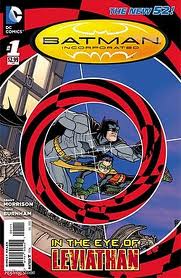Comics /
Back Issues
Backissue Retrospective: Grant Morrison and the Gospel of Batman
By Dan Horn
June 28, 2012 - 13:17
Writer Grant Morrison is no stranger to stirring up controversy (or at
the very least a little critical thinking), whether he's probing the
dizzying literal connotations of Dadaism, portraying a nude Queen
Elizabeth or the fantasy fulfillment of gunning down a boarding school
headmaster, metamorphosing Superman into a Bruce Springsteen sun god, or
reinterpreting William S. Burroughs' Naked Lunch to gut-wrenching
effect. Recently, his mainstream comics work in particular has piqued my
interest, however, and with the news that Morrison is receiving an MBE title
from the Queen of England (perhaps she was flattered by her bare depiction in Vimanarama) and with The Dark Knight Rises looming also,
I thought it was an appropriate juncture to pry analytically into some
of Grant's work on DC's Batman.
The instant which sparked this article was very recent actually, though
I'll be digging deeper into my back-issue annals in a bit. In the debut
installment of his second volume of Batman Incorporated, Morrison, via
Chris Burnham's gorgeous panels, presents a gruesome scene in which
Batman and Robin bust a Leviathan-run slaughter house. Between panels of
the father-son vigilante duo incapacitating goat-masked Leviathan
agents are disturbing images of cows being slain in quick succession,
bled-out, and gutted. From the goat imagery to the ritual sacrifice of calves, this scene has several symbolic implications, foremost a religious context whose broader parameters I will be examining, but it seems here Morrison is picking at a certain
psychological scab. Are copious amounts of gore acceptable when they do
not distinguishably originate from human bodies? It is a question that
begs an immediate visceral response from its viewer and one that thumbs
its nose at the inconsistencies and unviabilities of comic book rating
systems and censorship. Morrison's subversion here is of a more subtle
stock relative to his mature readers books because of Batman Inc's
somewhat mainstream manacles, but because of Morrison's prerogative to
supplant normative storytelling constructs, that subversion remains ever
present.
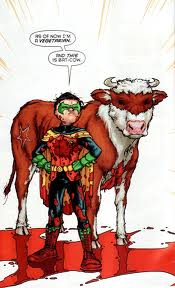 |
For that matter, Morrison's current Batman saga, spanning the gargantuan
run of Batman (Volume 1) #655-658, 663-683, and 700-702, Batman and
Robin (Volume 1) #1-16, Batman: The Return of Bruce Wayne #1-6, Batman: The Return, Batman
Incorporated (Volume 1) #1-8, Batman Incorporated: Leviathan Strikes!,
and Batman Incorporated (Volume 2) #1-present, seems like little more
than a deliberate and picaresque pastiche of the long-form comic tale.
The staggering longevity itself of the saga makes the story, each
chapter almost inextricably linked back to the beginning, difficult to
follow, and its mining of decades of obscure continuity minutia beyond
Morrison's own influence is enough to make a seasoned comics reader's
head spin. Even the reboot of DC's continuity has done little to rein in
Morrison's neurotic experiment in comic book convolution, leaving his
Batman Inc as perhaps the only series unscathed by the line-wide retcon
despite inclusion of or allusion to characters that no longer exist in
DC continuity (Stephanie Brown, Kathy Kane, Jezebel Jet, etc.).
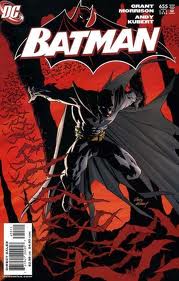 |
Morrison's parody doesn't end anywhere near there, though: the third
issue of Batman Inc (Vol 1) is written partially in Spanish, a surefire
way of infuriating American nativists (of which I spoke at length in the
first Backissue Retrospective); the seventh issue of that same
volume forces Americans to take a hard look at their own apartheid and
internalized third world colonies, Native American reservations; Batman
#663 is written in dense, absurdist text with ugly computer-generated
illustrations, another unequivocal method of aggravating people who are
too lazy or too inattentive to read; his very first Batman arc
introduced Bruce Wayne's illigitimate son Damien (this was interpreted
as comic apostasy in many circles); no less polarizing, he put his titular hero in yellow, purple, and red tights and armed him with a baseball bat for a few issues during the R.I.P. arc; finally, in the pages of
Final Crisis he killed Batman, and then almost immediately brought him
back from the dead (in which case Batman's death was then seen by many
as an exploitative marketing maneuver)! The list goes on and on and on.
Despite popular belief, Morrison's satire is never performed
sardonically, however. It's more of a love letter to the medium,
something that says, "See? I was paying attention all this time. Now
it's my turn." And accompanying his sense of irony is an equally
prevalent revisionist verve, but to assess those revisions of and their
mythic connotations to comic lore, we must look back at least two
decades.
Morrison's relationship with Batman began long before his current run,
with his and Dave McKean's best-selling Arkham Asylum graphic novel and the Legends of the
Dark Knight arc which I'll be focusing on for a moment, a five-issue
story entitled "Gothic" or "Gothic: A Romance" with art by Klaus Janson.
"Gothic" took full advantage of the continuity-free Batman book in its
fledgling months, exposing mainstream audiences to a berserk, satanic
fever dream as the unsettling story explored among many motifs the
Faustian immortality pact. For our purposes, it's worth noting a
particular Janson cover in this series, Legends of the Dark Knight #7,
as it relates to Morrison's Batman now. The cover at first glance seems
terribly odd, incongruous when compared to the fairly commercial
illustrations promoting the other four issues of "Gothic." An abstract,
unbalanced composition with no clear point of reference, an imperfect
linear perspective, and subtle hierarchic scaling, it certainly wouldn't
appeal generally to the average comic reader. However, the image does
evince something familiar, the religiosity and symbolism found in 15th
Century Northern European paintings.
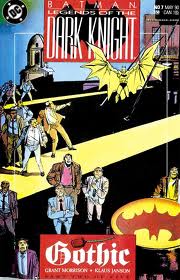 |
The background of the cover illustration contains in the right corner a
modern, brick, curtain-wall structure and toward the left corner the
parapet of a Gothic-revival cathedral. This in particular seems to
indicate a parallel of relative time periods: past and present or the
post-modern United States and its devoutly religious roots in Europe and
colonial America. Through the foreground of the image, criminals are
scattered across a rooftop like the somber and beleaguered denizens of
hell in a Hieronymous Bosch piece, an inverted Batsignal dominating the
bottom right corner like some heretical upside-down cross. Just below
the upper right corner is the signal's converse, Batman, weirdly
illuminated in the shadows between two rays of light, the only hope left
for the criminals who have gathered on this rooftop to summon him, yet
seemingly so far removed from them spatially, as if Batman exists on
some other plane apart from those around him. This image conjures occult
tonality and presages Morrison's radical presentation of Batman as a
Christ figure.
We see these classical art motifs once again in J.H. Williams III's
cover illustration for Batman Incorporated (Volume 1) #1, where Batman,
standing before a collage of national flags, is crowned by a Japanese
rising sun, like a plate halo adorning Christ in Gothic portrayals. The
same literary motifs appear time and again as well, most notably in the
death and resurrection of Bruce Wayne, Bruce's post-mortem excursion
through time-space reflecting the assertion of the Apostles' Creed that
Christ descended into hell after his crucifixion and the institution of
Batman Incorporated perhaps being an analogue of Christ's disciples
taking the Gospels abroad after the Ascension.
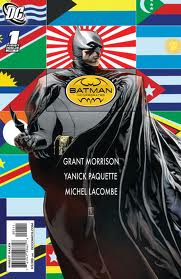 |
Similarly, Bruce's son, Damien, impish and impetuous, could easily be
interpreted as the Devil or the Antichrist. In both Batman #666 and
#700, an adult Damien is portrayed as a future Batman who is without his
father's values and without his belief in the sanctity of life. Damien
is a false prophet analogue, a former member of the host who has fallen
from grace. He is Lucifer, the antithesis of Christ, even with the best
of intentions. Then again, the Devil takes many forms in Morrison's
Batman comics, from Dr. Hurt and the Black Glove to Leviathan.
This deification of Batman and strict adherence to scriptural structure
might at first seem an implication of Morrison's personal religious
fervor, but that is not quite the case. Rather, Morrison handles the
transfiguration motifs like an extension of myth, a modern meme of an
old god, in much the same way Arthurian legend is continually repackaged
and retold, through stories like Star Wars, to preserve its thematic
essence yet to also present it to progressing audiences. The
identification alone which Morrison makes of the Christ figure as myth
is striking, and his assertion that comic books should be the modern
torchbearer of that myth is equally eyebrow-raising.
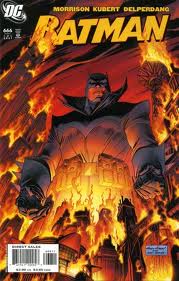 |
Morrison explains his view of comic books as purveyors of modern myth in
his slightly muddled non-fiction text, Supergods. He distinguishes the
superhero comic book from other pop-cultural media, like cinema,
literature, and even artistic and/or literary comic books, in that the
emphasis on superhumans makes the superhero comic a contemporary mythos
of gods similar to those found in ancient Greek and subsequently Roman
cultures. Morrison postulates that, whether we acknowledge it or not,
superheroes are the embodiment and the surviving cultural vestige of our
own pagan mythos in the same way that Catholic liturgical antiquity
reflects its non-Christian origins.
In this way, Morrison sees his own work on superhero comics as a
manipulation of that mythic fabric rather than mere storytelling solely
for the sake of entertainment. His addition of Batman to a long line of
resurrected messiah cognates, which includes Osiris, Achilles, and of course
Jesus of Nazareth, is profanely amusing in that the addition is meant to
be a literal transfiguration of a mythic figure rather than a literary
transfiguration of an admittedly fictional character or analogue, such
as Sydney Carton or Harry Potter.
The question is, with the death and resurrection already out of the way,
what comes next for a Christ figure, the book of Revelation? One thing
is certain: It will interesting to see what Morrison envisions as the
messiah's unwritten act.
Interested in reading more Backissue Retrospectives? You can find the other editorials in this series on ComicBookBin's Back Issues page.
Last Updated: January 17, 2025 - 08:20
